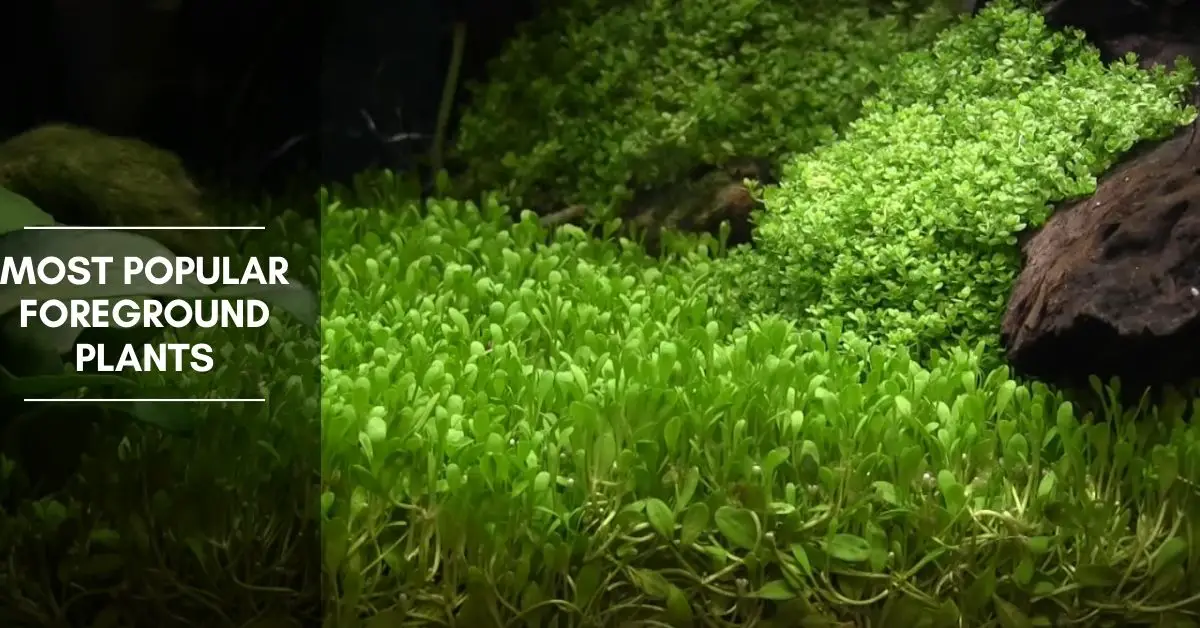In this post, I would like to do a top-five ranking of foreground carpet plants.
As some of you already know, I’m specialized in aquatic plant aquariums, and thus a lot of my readers are also aficionados of aquatic plants.
The main reason why I decided to create this post is that I often receive questions, on which aquatic plants they should choose, and also how they should choose aquatic plants.
As well as many aquarists wanting to know which freshwater plants are the most popular.
Utricularia Graminifolia
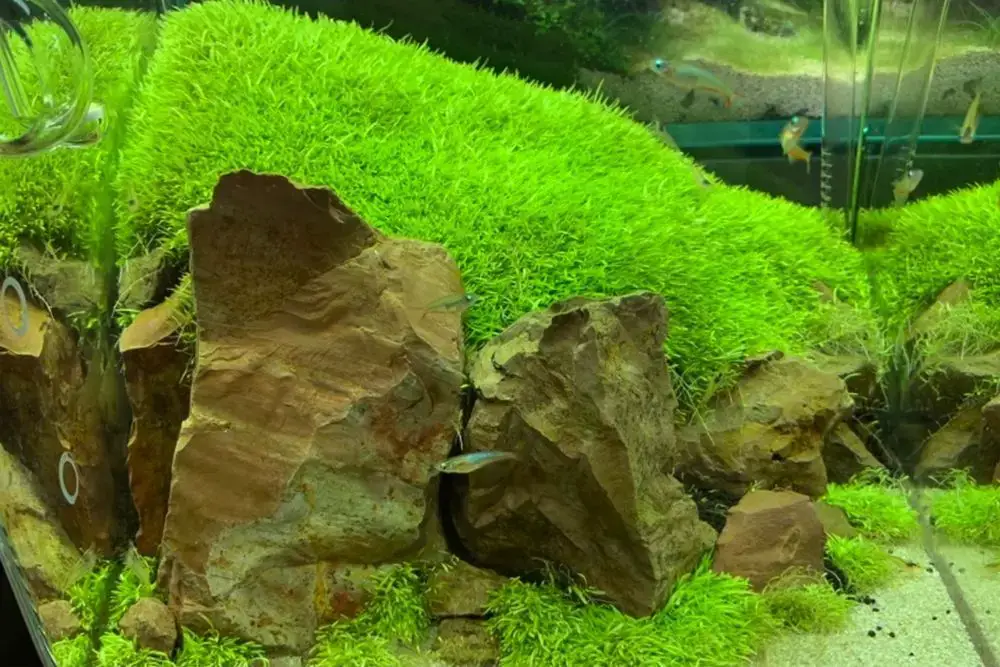
So let’s go ahead and start with fifth place, which is the Utricularia Graminifolia.
I’d like to go ahead and show you the tank where I currently growing some Utricularia Graminifolia, but I have to say this carpet plant is visually very unique and extremely beautiful.
If I just go off the visuals, I personally believe the Utricularia Graminifolia could rank in first or second place.
It’s very vibrant, especially when you plant them in the foreground, the vibrant green just makes the entire aquarium so much brighter.
However, as I mentioned before, this plant is visually top two or even top one material.
So now I would like to give my take on why it didn’t rank as high as it could have.
As a lot of you may know, the Utricularia Graminifolia are quite difficult to grow, and it takes some time and effort that is not necessarily required in other freshwater plants. This is probably why this plant ended up in fifth place, rather than somewhere in the top three.
The Utricularia Graminifolia grow pretty slowly, and a lot of them fall out or don’t grow sideways as we would like them to, so they’re pretty difficult to control.
But if you take a look at the aquarium image above, you can see that they’ve grown beautifully across the entire floor of the tank. This was done pretty easily by using a method called “The Mist method”.
This method makes the maintenance of Utricularia Graminifolia dramatically easier. So knowing this method makes a pretty big difference.
So although this plan is placed fifth, knowing the mist method makes it super easy and if more aquarists are able to easily maintenance this plant, I believe it would easily place in first or second.
Glossostigma Elatinoides
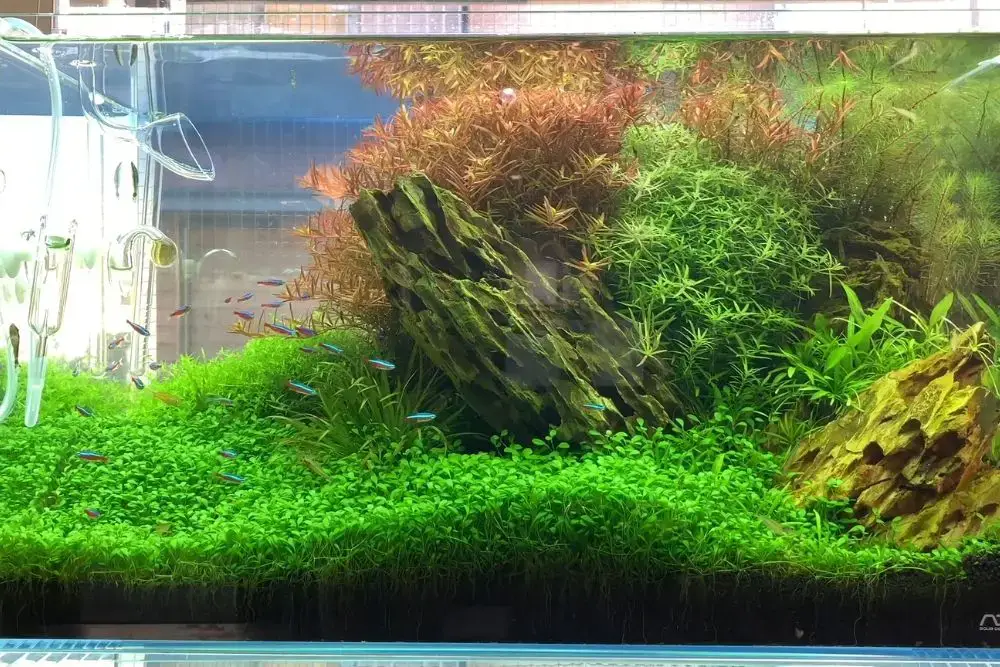
So now moving on to the fourth place, we have the Glossostigma Elatinoides.
I’m expecting this to be a surprise for a lot of my readers, as I believe you would imagine the Glossostigma to also ranked higher.
As a lot of you may know, the Glossostigma is extremely easy to take care of, and they grow very rapidly and widely. So it’ll easily spread across your foreground.
It’s also visually very beautiful and I would strongly recommend this to beginners or those with not as much experience in aquatic plant aquariums. So, why did the Glossostigma rank in fourth place?
This I believe is how sensitive it is to the strength of light.
API STRESS ZYME Freshwater and Saltwater Aquarium Cleaning Solution 16-Ounce Bottle
API ACCU-CLEAR Freshwater Aquarium Water Clarifier 4-Ounce Bottle
30% OffTetra Water Clarifier, Aquarium Treatment Solution, 8.45 oz, Clears Cloudy Aquarium Water, Safe to Use with Fish and Plants, For Fresh Water
$8.49 (as of June 29, 2025 06:58 GMT +03:00 - More infoProduct prices and availability are accurate as of the date/time indicated and are subject to change. Any price and availability information displayed on [relevant Amazon Site(s), as applicable] at the time of purchase will apply to the purchase of this product.)One unique trait about the Glossostigma is that without a strong amount of light it grows upwards rather than spreading across the floor.
So the fact that it is contingent on your equipment may have caused this carpet plant to rank in fourth rather than may be higher in the top three.
However, if you have the right amount of light, Glossostigma grows very rapidly, and beautifully across your foreground. So it’s still very easy to use.
One more reason why the Glossostigma may have landed in fourth place is that it’s a bit difficult to maintain in smaller aquariums.
If you look closely its leaves are pretty large in size. Of course, if you trim them consistently you can maintain their size, but since they take in a large amount of nutrition directly from the floor, they grow to become large pretty rapidly.
So although I wouldn’t go as far as to say they don’t match a small-sized aquariums, it definitely takes more effort to contain them. So I think that is also a reason why they ranked fourth place.
I definitely think that a few years back, Glossostigma could easily rank in first or second place, but the recent increase of different types of foreground plants may have pushed the Glossostigma down to the fourth place.
But overall they are very easy to maintain, so I would still strongly recommend Glossostigma to anyone.
Hemianthus Callitrichoides – HC Cuba
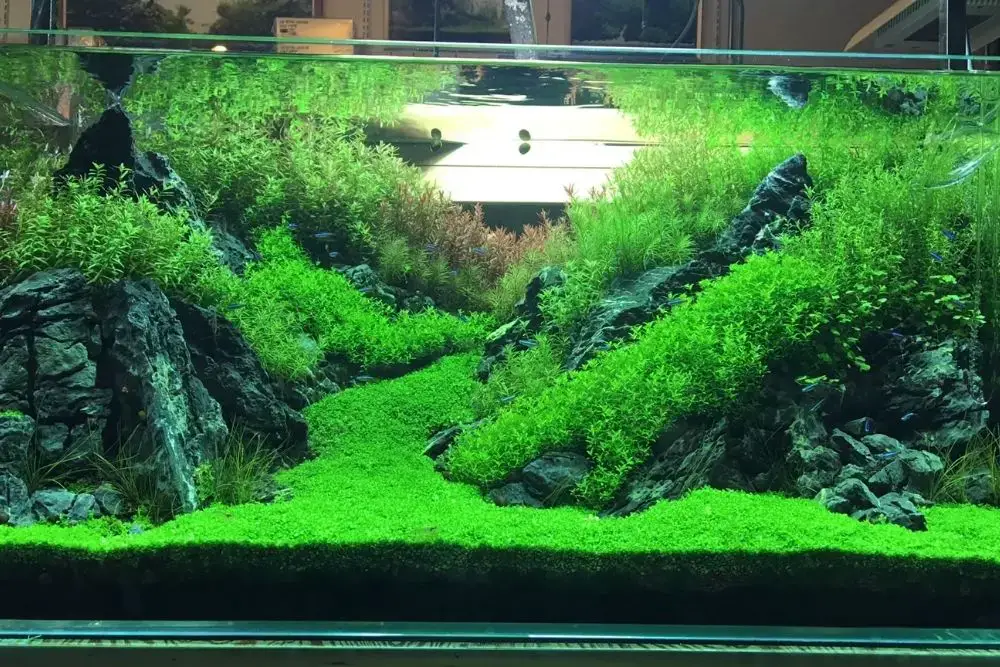
The third place is the HC Cuba. The HC Cuba is all about its beauty.
It’s almost stunning to see the thin leaves spread out across your foreground.
It’s somewhat the opposite of natural or Wild.
But the HC Cuba can give you a beautiful consistent green across your floor, and you can almost say the visuals of HC Cuba push them up to third place.
However, I must also say that the reason why they couldn’t rank first or second is because of maintenance difficulties. HC Cuba is very sensitive to the water.
So it tends to become weak when the water is too soft, or if there is a lack of waves in the water.
It also grows pretty slowly, so there are some areas where people may have found the HC Cuba to be a bit difficult to grow and maintain.
But these issues can easily be solved by placing some stones that harder the water or increasing Co2 and maintaining a strong level of light, allows the HC Cuba to grow consistently and rapidly.
So it’s definitely one of the less difficult plants to maintain, so I would recommend everyone to try using the HC Cuba in your aquarium at least once, as it is visually extremely beautiful as I mentioned earlier.
Eleocharis Parvula
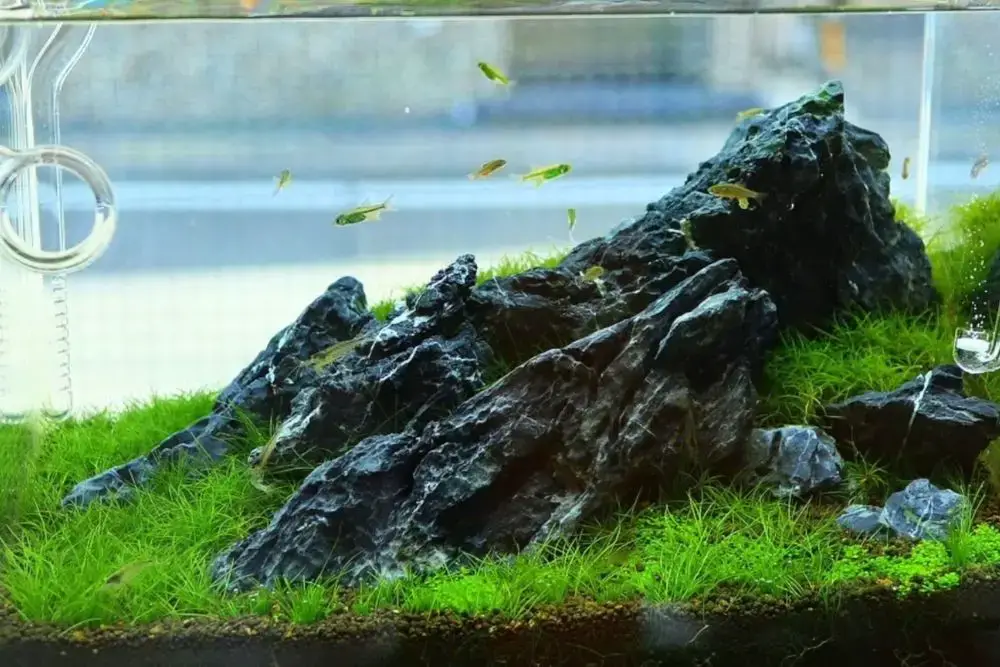
The foreground plant in the second place is the Eleocharis Parvula. Unlike the HC Cuba, the leaves of the Eleocharis Parvula grow pretty large in size.
So overall it gives a fluffy and more natural wild impression to the aquarium, rather than a straight clean green floor like the HC Cuba.
This fluffy look is actually very popular, but I must say most people preference definitely splits between the clean, tidy, vibrant look versus the more grassy wild, and natural look like the Eleocharis Parvula that ranked in second place.
It was very interesting to see aquarists choose this plant, as it was most likely purely based on visual preference.
As I mentioned earlier, second and third place were very close.
But I believe that the reason why the Eleocharis Parvula came up by a bit, was once again how easily it can be maintained.
Long story short, the Eleocharis Parvula is very easy to maintain in many ways.
It can grow in both soft and hard water, and although the stronger the better, it doesn’t require too much light, and it steadily grow without as much Co2. Although the more the better, of course.
So maintenance is very easy, and it can also accompany a variety of aquariums.
One trait about the Eleocharis Parvula is that the leaves grow out in length, and it may overshadow your stones or your wood.
So when using Eleocharis Parvula in your aquarium, it is usually better to place large pieces of stone and wood.
Monte Carlo Plant
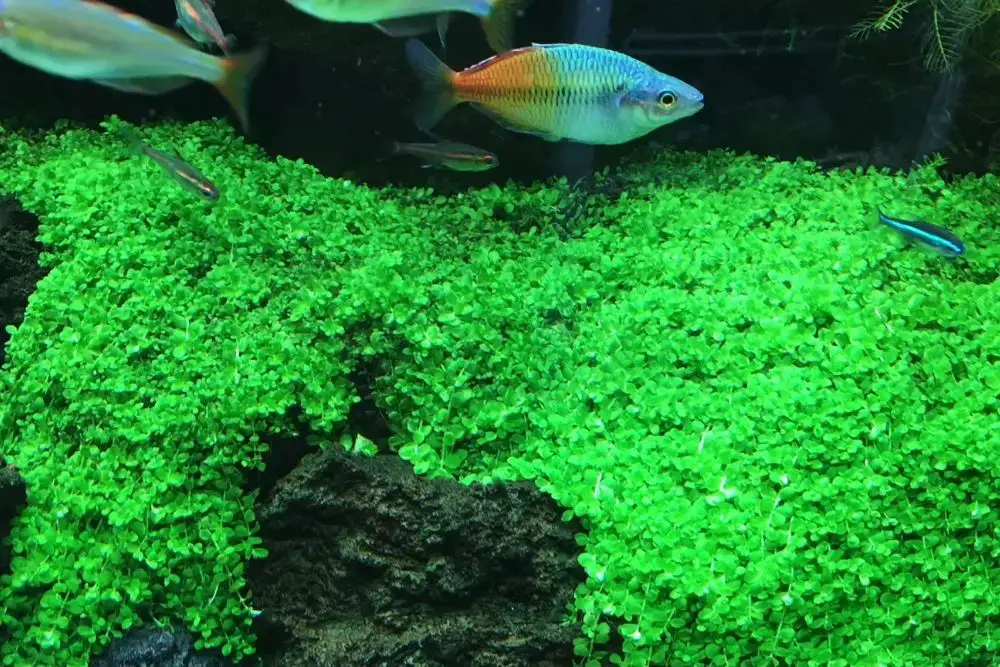
Now finally moving on to the most popular foreground plant by far I must say, I know most of you know the answer by now.
Yes, It’s the Monte Carlo!
As some of you may have expected from the start, they were the champions way ahead of everyone else. The Monte Carlo is simply beautiful.
It grows out to be a stunning nice and tidy green floor, it grows fast, it’s easy to maintain, so I believe its popularity is simply based on the fact that it’s an almighty beautiful aquatic carpet plant.
If we were to compare the plants in a pentagon data graph, the Monte Carlo would definitely hit every category above average and will have the most balanced data.
It’s even easy to nurture and it does not require strong lighting or an excess amount of Co2, so it’s just as easy to maintain as the Eleocharis parvula. But the Monte Carlo plant definitely grows a lot faster than the Eleocharis Parvula. Additionally, Eleocharis Parvula are pretty small individually.
So they actually require large amounts in order for them to fill the foreground.
But the Monte Carlo plants are almost perfect in size, and an average amount can easily fill up your aquarium.
So once again, the traits of the Monte Carlo simply make it the easiest choice when you choose your aquatic plants.
Visually, the small leaves of the Monte Carlo give off a bright light greenish color.
Unlike the Glossostigma which works best for 30-Gallon aquariums.
The Monte Carlo works perfectly for a variety of tanks from 60, 90, or even 10-gallon tanks.
And they grow very easily and rapidly, so there’s just no weaknesses to point out which I believe is the reason why they’re so popular.
Conclusion
Overall, this ranking definitely made me realize that aquarists’ choices are very logical.
Visuals and maintenance are definitely the two biggest factors in choosing your aquatic plants.
For those who are used to growing and maintaining aquatic plants and aquariums, the maintenance factor may not matter as much, so I’m sure there were a lot of people who also chose their plants purely from a performance point of view, which I think is also a good thing.

Hi, my name is Sean, and I’m the primary writer on the site. I’m blogging mostly about freshwater and saltwater aquariums, fish, invertebrates, and plants. I’m experienced in the fishkeeping hobby for many years. Over the years I have kept many tanks, and have recently begun getting more serious in wanting to become a professional aquarist. All my knowledge comes from experience and reading forums and a lot of informative sites. In pursuit of becoming a professional, I also want to inspire as many people as I can to pick up this hobby and keep the public interest growing.
Read more about Sean.
Please join also my Facebook group.

